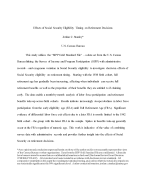
An official website of the United States government
Here’s how you know
Official websites use .gov
A .gov website belongs to an official government organization in the United States.
Secure .gov websites use HTTPS
A lock (
) or https:// means you’ve safely connected to the .gov website. Share sensitive information only on official, secure websites.
-
//
- Census.gov /
- Library /
- Census Working Papers /
- Effects of Social Security Eligibility Timing on Retirement Decisions
Effects of Social Security Eligibility Timing on Retirement Decisions
Effects of Social Security Eligibility Timing on Retirement Decisions
Introduction
This study utilizes the “SIPP Gold Standard File” – a data set from the U.S. Census Bureau linking the Survey of Income and Program Participation (SIPP) with administrative records – and exogenous variation in Social Security eligibility to investigate short-run effects of Social Security eligibility on retirement timing. Starting with the 1938 birth cohort, full retirement age has gradually been increasing, affecting when individuals can receive full retirement benefits as well as the proportion of their benefits they are entitled to if claiming early. The data enable a month-by-month analysis of labor force participation and retirement benefits take-up across birth cohorts. Results indicate increasingly steeper declines in labor force participation from the early eligibility age (EEA) until Full Retirement Age (FRA). Significant evidence of differential labor force exit effects due to a later FRA is mostly limited to the 1942 birth cohort – the group with the latest FRA in the sample. Spikes in benefits take-up generally occur at the FRA regardless of numeric age. This work is indicative of the value of combining survey data with administrative records and provides further insight into the effects of Social Security on retirement decisions.
Others in Series
Working Paper
Working Paper
Working Paper
Share
Related Information
Some content on this site is available in several different electronic formats. Some of the files may require a plug-in or additional software to view.
 Yes
Yes
 No
NoComments or suggestions?


Top

